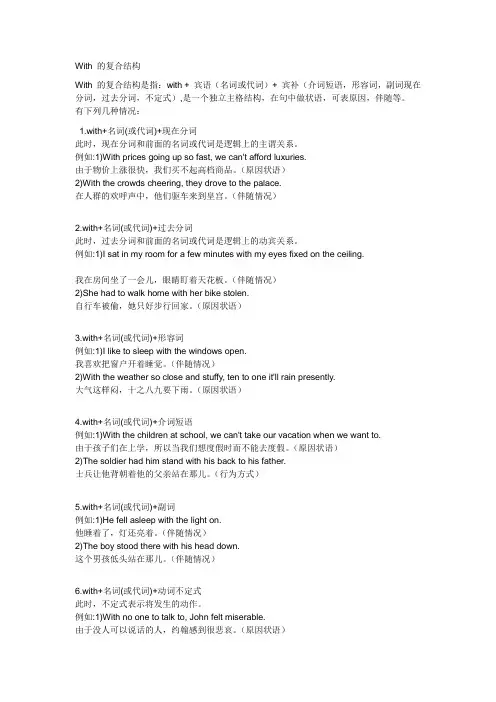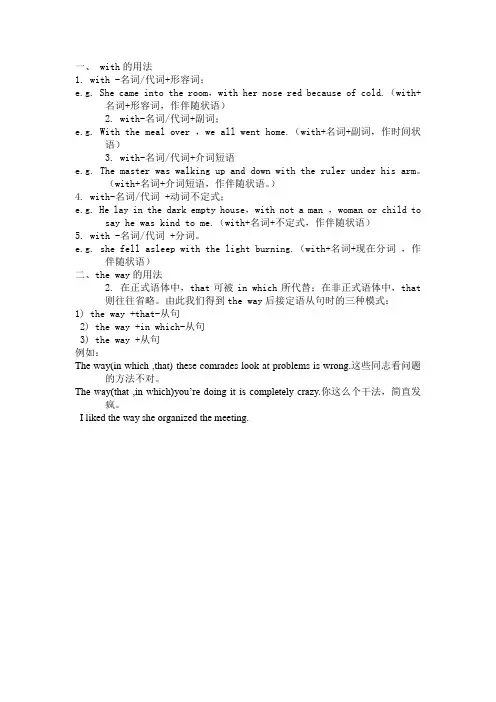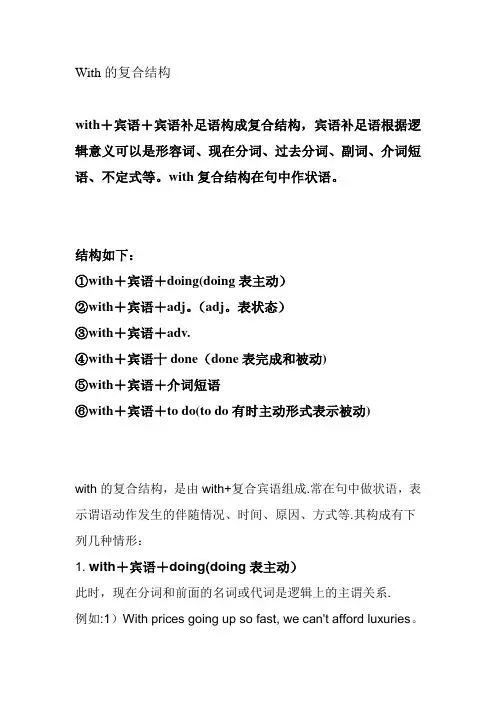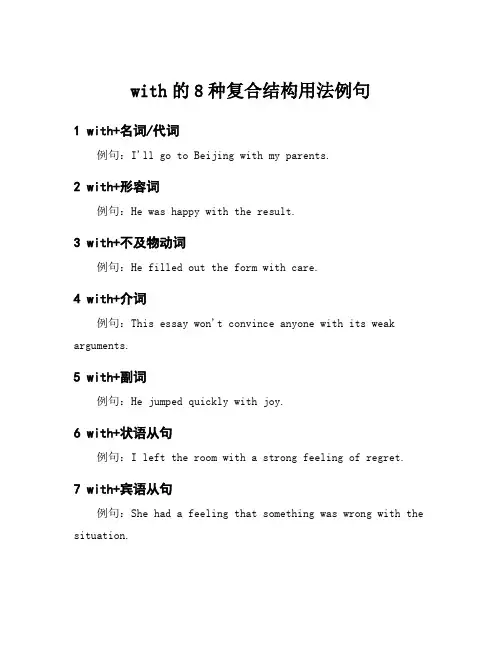with的复合结构的用法
- 格式:ppt
- 大小:142.00 KB
- 文档页数:8

With 的复合结构With 的复合结构是指:with + 宾语(名词或代词)+ 宾补(介词短语,形容词,副词现在分词,过去分词,不定式),是一个独立主格结构,在句中做状语,可表原因,伴随等。
有下列几种情况:1.with+名词(或代词)+现在分词此时,现在分词和前面的名词或代词是逻辑上的主谓关系。
例如:1)With prices going up so fast, we can't afford luxuries.由于物价上涨很快,我们买不起高档商品。
(原因状语)2)With the crowds cheering, they drove to the palace.在人群的欢呼声中,他们驱车来到皇宫。
(伴随情况)2.with+名词(或代词)+过去分词此时,过去分词和前面的名词或代词是逻辑上的动宾关系。
例如:1)I sat in my room for a few minutes with my eyes fixed on the ceiling.我在房间坐了一会儿,眼睛盯着天花板。
(伴随情况)2)She had to walk home with her bike stolen.自行车被偷,她只好步行回家。
(原因状语)3.with+名词(或代词)+形容词例如:1)I like to sleep with the windows open.我喜欢把窗户开着睡觉。
(伴随情况)2)With the weather so close and stuffy, ten to one it'll rain presently.大气这样闷,十之八九要下雨。
(原因状语)4.with+名词(或代词)+介词短语例如:1)With the children at school, we can't take our vacation when we want to.由于孩子们在上学,所以当我们想度假时而不能去度假。


with的七种复合结构以with的七种复合结构为标题,写一篇文章一、with的复合结构介绍with是一个常见的英语连接词,用于引出一种复合结构,可以在句子中引出不同的状语从句、名词从句、分词短语等。
本文将介绍with的七种复合结构及其用法。
二、with + 名词从句1. 表示伴随关系例如:With the development of technology, our lives have become more convenient.(随着科技的发展,我们的生活变得更加便利。
)2. 表示条件关系例如:With your help, I can finish the task on time.(在你的帮助下,我能按时完成任务。
)三、with + 分词短语1. 表示伴随关系例如:With his hands trembling, he opened the letter.(他的手颤抖着,他打开了那封信。
)2. 表示方式关系例如:He spoke with a smile on his face.(他脸上带着微笑说话。
)四、with + 副词从句1. 表示条件关系例如:She can't go out with you unless her parents agree.(除非她的父母同意,否则她不能和你出去。
)2. 表示让步关系例如:With all his efforts, he still failed the exam.(尽管他努力了,但他还是考试不及格。
)五、with + 现在分词1. 表示原因关系例如:He was late for the meeting with his car breaking down.(由于他的车出故障,他迟到了会议。
)2. 表示方式关系例如:She walked into the room with a book in her hand.(她手里拿着一本书走进了房间。

with结构也称为with复合结构,是由with+复合宾语(宾语+宾语补足语)组成一. with复合结构在句中做状语,表示谓语动作发生的伴随情况、时间、原因、方式等.其构成有下列几种情形:1、with + 名词 (或代词) + 现在分词此时,现在分词和前面的名词或代词是逻辑上的主谓关系.例如:With prices going up so fast,we can't afford luxuries.由于物价上涨很快,我们买不起高档商品.(原因状语)With the crowds cheering,they drove to the palace.在人群的欢呼声中,他们驱车来到皇宫.(伴随情况) With the bay leading the way,I found the village easily.2、with + 名词 (或代词) + 过去分词此时,过去分词和前面的名词或代词是逻辑上的动宾关系.例如:I sat in my room for a few minutes with my eyes fixed on the ceiling.我在房间坐了一会儿,眼睛盯着天花板.(伴随情况)She had to walk home with her bike stolen.自行车被偷,她只好步行回家.(原因状语)3、with + 名词 (或代词) + 形容词I like to sleep with the windows open.我喜欢把窗户开着睡觉.(伴随情况)With the weather so close and stuffy,ten to one it'll rain presently.大气这样闷,十之八九要下雨.(原因状语)4、with + 名词 (或代词) + 介词短语With the children at school,we can't take our vacation when we want to.由于孩子们在上学,所以当我们想度假时而不能去度假.(原因状语)The professor came in with a book in his hand(伴随状语)5、with + 名词 (或代词) + 副词He fell asleep with the light on.他睡着了,灯还亮着.(伴随情况)The boy stood there with his head down.这个男孩低头站在那儿.(伴随情况)John was lying on the bed with all his clothes on.6 、with + 名词 (或代词) + 动词不定式此时,不定式表示将发生的动作.例如:With no one to talk to,John felt miserable.由于没人可以说话的人,约翰感到很悲哀.(原因状语)With a lot of work to do,he wasn't allowed to go out.因为还有很多工作要做,他没有被允许外出.(原因状语)在with without 的复合结构中,多数情况下with 能省略,但without 不能省略。


一、 with的用法1. with -名词/代词+形容词;e.g. She came into the room,with her nose red because of cold.(with+名词+形容词,作伴随状语)2. with-名词/代词+副词;e.g. With the meal over ,we all went home.(with+名词+副词,作时间状语)3. with-名词/代词+介词短语e.g. The master was walking up and down with the ruler under his arm。
(with+名词+介词短语,作伴随状语。
)4. with-名词/代词 +动词不定式;e.g. He lay in the dark empty house,with not a man ,woman or child tosay he was kind to me.(with+名词+不定式,作伴随状语)5. with -名词/代词 +分词。
e.g. she fell asleep with the light burning.(with+名词+现在分词,作伴随状语)二、the way的用法2. 在正式语体中,that可被in which所代替;在非正式语体中,that则往往省略。
由此我们得到the way后接定语从句时的三种模式:1) the way +that-从句2) the way +in which-从句3) the way +从句例如:The way(in which ,that) these comrades look at problems is wrong.这些同志看问题的方法不对。
The way(that ,in which)you’re doing it is completely crazy.你这么个干法,简直发疯。
I liked the way she organized the meeting.。

with 的用法有哪些复合结构用法例句
With 复合结构是由介词with 或without+复合结构构成,复合结构作介词
with 或without 的复合宾语,复合宾语中第一部分宾语由名词或代词充当,第
二部分补足语由形容词、副词、介词短语或非谓语动词充当。
1with 的六种用法含例句1.表示方式、手段或工具等时(=以,用),如:with
a car 用卡车
2. 与某些抽象名词连用时,其作用相当于一个副词.如:
with care=carefully 认真地
with kindness=kindly 亲切地
3. 表示条件时,根据情况可与虚拟语气连用.如:
With more money I would be able to buy it. 要是钱多一点,我就买得起了.
With better equipment, we could have finished the job even sooner. 要是设备好些,我们完成这项工作还要快些.
4. 比较with 和as:两者均可表示“随着”,但前者是介词,后接名词或代词;
后者是连词,用于引导一个句子.比较:
He will improve as he grows older. 随着年龄的增长,他会进步的.
People’s ideas change with the change of the times. 时代变了,人们的观念也会变化.
5. 复合结构“with+宾语+宾语补足语”是一个很有用的结构,它在句中主要用
作状语,表示伴随、原因、时间、条件、方式等;其中的宾语补足语可以是名
词、形容词、副词、现在分词、过去分词、不定式、介词短语等.如:。

With的复合结构with+宾语+宾语补足语构成复合结构,宾语补足语根据逻辑意义可以是形容词、现在分词、过去分词、副词、介词短语、不定式等。
with复合结构在句中作状语。
结构如下:①with+宾语+doing(doing表主动)②with+宾语+adj。
(adj。
表状态)③with+宾语+adv.④with+宾语十done(done表完成和被动)⑤with+宾语+介词短语⑥with+宾语+to do(to do有时主动形式表示被动)with的复合结构,是由with+复合宾语组成.常在句中做状语,表示谓语动作发生的伴随情况、时间、原因、方式等.其构成有下列几种情形:1. with+宾语+doing(doing表主动)此时,现在分词和前面的名词或代词是逻辑上的主谓关系.例如:1)With prices going up so fast, we can't afford luxuries。
由于物价上涨很快,我们买不起高档商品。
(原因状语)2)With the crowds cheering, they drove to the palace.在人群的欢呼声中,他们驱车来到皇宫。
(伴随情况)2。
with+宾语十done(done表完成和被动)此时,过去分词和前面的名词或代词是逻辑上的动宾关系。
例如:1)I sat in my room for a few minutes with my eyes fixed on the ceiling。
我在房间坐了一会儿,眼睛盯着天花板。
(伴随情况)2)She had to walk home with her bike stolen。
自行车被偷,她只好步行回家。
(原因状语)3。
with+宾语+adj或者adv。
(表状态)例如:1)I like to sleep with the windows open。
我喜欢把窗户开着睡觉。
(伴随情况)2)With the weather so cold and wet,we can’t go out for picnic today。

with复合结构用法归纳With 复合结构指的是“with+宾语+宾语补足语”结构,它是一个十分有用的结构,不仅教材中经常出现,考试中经常考到,而且它也是同学们写作时使句子变得“高级”的一个重要手段。
学会正确运用它,你会多方面受益。
with复合结构形式一:with+宾语+形容词He often sleeps with the windows open. 他常开着窗睡觉。
Don’t speak with your mouth full. 不要满嘴巴食物说话。
with复合结构形式二:with+宾语+副词He stood before his teacher with his head down. 他低着头站在老师面前。
He was lying on the bed with all his clothes on. 他和衣躺在床上。
with复合结构形式三:with+宾语+名词He died with his daughter yet a schoolgirl. 他去世时,女儿还是个小学生。
with复合结构形式四:with+宾语+介词短语She said good-bye with tears in her eyes. 她含着眼泪说了声再见。
He was asleep with his head on his arms. 他头枕着胳膊睡着了。
with复合结构形式五:with+宾语+现在分词(短语)He fell asleep with the lamp burning. 他没熄灯就睡着了。
I won’t be able to go on holiday with my mother being ill. 因为妈妈有病,我无法去度假。
with复合结构形式六:with+宾语+过去分词(短语)He sat there with his eyes closed. 他闭目坐在那儿。
All the afternoon he worked with the door locked. 整个下午他都锁着门在房里工作。

with的8种复合结构用法例句1 with+名词/代词例句:I'll go to Beijing with my parents.2 with+形容词例句:He was happy with the result.3 with+不及物动词例句:He filled out the form with care.4 with+介词例句:This essay won't convince anyone with its weak arguments.5 with+副词例句:He jumped quickly with joy.6 with+状语从句例句:I left the room with a strong feeling of regret.7 with+宾语从句例句:She had a feeling that something was wrong with the situation.8 with+状语动词例句:She played with enthusiasm.with复合结构十分常见,它和其他的复合结构有着很多共同特点,同时又有着其独特性。
with复合结构通常用来说明各部分之间的关系,可以用来提供状态、情感或变化等信息。
with复合结构可以用来表达任何我们心目中想象的东西。
with作为复合结构时,有以下8种结构用法:1 与名词或代词形成的复合结构,例如:I'll go toBeijing with my parents(我将与父母一起去北京);2 与形容词形成的复合结构,例如:He was happy with the result(他对结果很满意);3 与不及物动词形成的复合结构,例如:He filled out the form with care(他仔细填写了该表格);4 与介词形成的复合结构,例如:This essay won't convince anyone with its weak arguments(这篇文章因其弱小的论点而无法说服任何人);5 与副词形成的复合结构,例如:He jumped quickly with joy(他高兴地跳跃);6 与状语从句形成的复合结构,例如:I left the room with a strong feeling of regret(我强烈地后悔离开了房间);7 与宾语从句形成的复合结构,例如:She had a feeling that something was wrong with the situation(她有一种感觉,觉得情况不太对劲);8 与状语动词形成的复合结构,例如:She played with enthusiasm(她热情洋溢地玩耍)。

With复合结构的用法with复合结构即“with + 宾语 + 宾语补足语或with + 复合宾语”。
宾语补足语(简称:宾补)可以是动词不定式、现在分词、过去分词、形容词、副词或介词短语等。
With 复合结构在句中常充当状语,有时也充当定语或补足语。
一、with复合结构的类型with复合结构常有以下六种形式:1、with + 宾语 + 不定式(短语)【不定式表将来,主动表被动】With a lot of difficult problems so settle, the newly-elect president is having a hard time.With you to help us, we’ll surely succeed.I cannot go out with all these dishes to wash.With all the work to do, I don’t know if I’ll have time to go out.With five minutes to go before the last train, we arrived at the station.2、with + 宾语 + 现在分词(短语)【正在发生】I felt quite happy with the birds singing in the woods.With the old man leading, the soldiers started towards the mountain.Thousands of terrified watchers stared with their hearts beating fast.With all the family traveling in America, the house seems very empty.In some parts of Asia, it’s not polite to sit with your foot pointing at another person.With so many people communicating in English every day, it will become more and more important to have a good knowledge of English.3、with + 宾语 + 过去分词(短语)【过去分词与它前面的名词或代词有被动关系】All the afternoon he worked with the door locked.The murderer was brought in, with his hands tied behind his back.He wept in his room with his heart broken.He enjoys listening to music with his eyes closed.With the job finished, we went to the seaside for a holiday.You must give me a true account, with nothing added and nothing removed.4、with + 宾语 + 形容词【形容词表状态、特征】He stared at me with his mouth open.She sat in the corner, with her face dull.He cannot go on a holiday with his mother ill.He often sleeps with the windows open even in winter.In summer we often sleep with the windows open.With everything ready, we started to work.5、with + 宾语 + 副词Our city looks more beautiful with all the lights on.He went out with no hat on.He put on his socks, (with me) wrong side out.With Mary away, John felt miserable.6、with + 宾语 + 介词短语He stood with his hand in his pocket.He was asleep with his head on his arms.The teacher stood here with a book in her hand.The teacher walked into the classroom with a ruler under his arm.The guard rushed out with a gun in his hand.二、with复合结构的用法with复合结构主要用来说明附带情况或具体细节,在句中主要用作状语,有时也用作定语、宾语补足语或主语补足语。
with复合结构的用法一“with复合结构”的定义及构成即 with + 宾语 + 宾语补足语例如With his homework finished, he went out playing football with his friends happily.二“with复合结构”的用法01with + 宾语 + 副词The square looks more beautiful with all the lights on.所有的灯都亮时,广场显得更加美丽。
With his parents away, Tom becomes naughtier.父母不在,汤姆变得更淘气。
02with + 宾语 + 形容词With the door and windows open, the room was very cold.门窗大开,屋内很冷。
With her parents dead, the girl had to left school.她父母死了,那女孩只好辍学。
03with + 宾语 + 介词短语The teacher came in with a book in his hand.老师手里拿着书走进来。
The girl looked up with tears in her eyes.那女孩眼泪汪汪地抬起头。
04with + 宾语 + 名词They set up a football team, with Tom their head.他们建立了一支足球队,汤姆当队长。
With a native our guide, we needn't be afraid to get lost.有本地人当向导,我们不必担心会迷路。
05with + 宾语 + 现在分词(宾语与动作构成逻辑上的主谓关系)With summer coming, the weather is becoming hotter and hotter.随着夏天的到来,天气越来越热。
with的复合结构介词with的复合结构一. “with + 宾语+ 宾语补足语”构成介词with的复合结构,该结构在句中可作状语和定语。
在with复合结构中,宾语和宾补之间形成逻辑上的主谓关系。
当这种主谓关系表现为主动语态时,用现在分词;当这种主谓关系表现为被动语态时,用过去分词;当这种主谓关系表示将来意义时,用不定式;当这种主谓关系表示伴随意义时,用现在分词或副词。
常见的结构:1. with + 宾语+ 介词短语1) He walked along the street with his hands in his pockets. (用作状语,宾补为介词短语)他手插衣袋沿街走着。
2) A girl stood at the door with an umbrella in her hands. (用作状语,宾补为介词短语)一位姑娘站在门口,手里拿着一把雨伞。
3) There were rows of white houses with trees in front of them. (用作定语,宾补为介词短语)这儿有一排排白色的房子,房前长着树木。
4) She saw a brook with red flowers and green grass on both sides.(用作定语,宾补为介词短语)她看到一条小溪,两岸长着红花绿草。
5) She left the office with tears in her eyes. (用作状语,宾补为介词短语)她眼里含着泪水,离开了办公室。
2. with + 宾语+ 形容词1) Why did you sleep with the windows open? (用作状语,宾补为形容词)你为什么开着窗子睡觉?2) She sat down with her face pale with pain. (作状语,宾补为形容词)她坐下来,痛的脸色发白了。
with的复合结构即with+宾语+宾语补足语1、 with + n/pron + done( 其中n/pron与done是动宾关系)With everything bought, I went home.买好东西,我就回家了。
With my homework done, I went out to play basketball.做好了作业,我出去打篮球了。
2.with + n/pron + doing. (其中n/pron 与 doing是主谓关系)With many people surrounding him, he felt really upset.这么多人围着他,他真的感觉很紧张。
With all of you helping me, I finished my work in advance. 有你们帮我,我已经提前完成任务了。
3、with + n/pron + to do(其中to do 表将来)With so much work to do, I have to stay behind after work. 有这么多工作要做,我只好留下来加班。
With lots of problems to solve, I feel restless.有这么多问题需要解决,我感到坐立不安。
4、with + n/pron + adv.(其中adv.表示其前面n/pron的状态) With all the lights on, he left the room.房间里的灯都开着他就走了。
With his computer off, he wanted to deal with his papers tomorrow.已经关了电脑,他决定明天处理这些文件。
5、with + n/pron + prep.phrase(介词短语表状态)With a book in his hand, our teacher came in.老师手里拿着书走进来。
with 复合结构用法都有什么with结构是许多英语复合结构中最常用的一种。
学好它对学好复合宾语结构、不定式复合结构、动名词复合结构和独立主格结构均能起很重要的作用。
本文中,小编整理了相关知识,欢迎阅读。
with复合结构基本用法一、with或without+名词/代词+形容词例句:1.I like to sleep with the windows open.我喜欢把窗户开着睡觉。
(伴随情况)2.With the weather so close and stuffy, ten to one itll rain presently.大气这样闷,十之八九要下雨(原因状语)二、with或without+名词/代词+副词例句:1.She left the room with all the lights on.她离开了房间,灯还亮着。
(伴随情况)2.The boy stood there with his head down.这个男孩低头站在那儿。
(伴随情况)三、with或without+名词/代词+介词短语例句:1.He walked into the dark street with a stick in his hand.他走进黑暗的街道时手里拿着根棍子。
(伴随情况)2. With the children at school, we cant take our vacation when we want to.由于孩子们在上学,所以当我们想度假时而不能去度假。
(原因状语)四、with或without+名词/代词+非谓语动词1、with或without+名词/代词+动词不定式,此时,不定式表示将发生的动作。
例句: 1.With no one to talk to, John felt miserable.由于没人可以说话的人,约翰感到很悲哀。
(原因状语)2. With a lot of work to do, he wasnt allowed to go out.因为还有很多工作要做,他没有被允许外出。
with的七种复合结构用法一、with+复合宾语。
这种结构表示“用某物做某事”,with后跟表示“手段”或“方法” (如:words,tools,hands,a knife,a hammer,tissues,mathematics,a pen,a pencil)的名词或动词不定式。
例如:He repaired the chair with a hammer. 他用锤子修理了椅子。
My daughter has done her homework with a pen. 我的女儿用钢笔做家庭作业。
二、with+复合主语。
这种结构表示“把某人和某人或某事联系在一起”,with后跟人或事物名词,也可以跟代词。
例如:My brother lives with his grandmother. 我兄弟和他的奶奶住在一起。
I am very familiar with the city. 我对这个城市很熟悉。
三、with+复合状语。
这种结构表示“带着某物”或“伴随着某事”,with后跟表示“手段”或“方法”(如:courage,honors,tears,patience,applause,a smile)的名词或动词不定式。
例如:He arrived with a smile. 他带着微笑到达。
She graduated with honors. 她以优异成绩毕业。
四、with+复合表语。
这种结构表示“和……一起”,with后跟名词、代词、形容词或动词不定式。
例如:The house is furnished with modern furniture. 这个房子里有现代家具。
The room is filled with sunshine. 这个房间里充满阳光。
五、with+复合宾语从句。
这种结构表示“做某事时考虑某事”,with后有从句,这个从句有时是否定的。
例如:He dealt with the problem with much patience. 他耐心地处理这个问题。